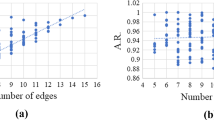Abstract
In order to formulate mathematical conjectures likely to be true, a number of base cases must be determined. However, many combinatorial problems are NP-hard and the computational complexity makes this research approach difficult using a standard brute force approach on a typical computer. One sample problem explored is that of finding a minimum identifying code. To work around the computational issues, a variety of methods are explored and consist of a parallel computing approach using MATLAB, an adiabatic quantum optimization approach using a D-Wave quantum annealing processor, and lastly using satisfiability modulo theory (SMT) and corresponding SMT solvers. Each of these methods requires the problem to be formulated in a unique manner. In this paper, we address the challenges of computing solutions to this NP-hard problem with respect to each of these methods.









Similar content being viewed by others
References
Babbush, R., O’Gorman, B., Aspuru-Guzik, A.: Resource efficient gadgets for compiling adiabatic quantum optimization problems. arXiv:1307.8041v1 [quant-ph]
Barrett, C., Sebastiani, R., Seshia, S.A., Tinelli, C.: Satisfiability modulo theories. In: Biere, A., Huele, M., van Maaren, H., Walsh, T. (eds.) Handbook of Satisfiability, pp. 825–885. Amsterdam, Netherlands, IOS Press (2009)
Boixo, S., Albash, T., Spedalieri, F.M., Chancellor, N., Lidar, D.A.: Experimental signature of programmable quantum annealing. Nat. Commun. 4, 2067 (2013)
Boutin, D., Horan, V., Pelto, M.: Identifying Codes on Directed De Bruijn Graphs. arXiv:1412.5842v2 (submitted)
Cai, J., Macready, W.G., Roy, A.: A practical heuristic for finding graph minors. arXiv:1406.2741v1 [quant-ph]
Charon, I., Hudry, O., Lobstein, A.: Minimizing the size of an identifying or locating-dominating code in a graph is NP-Hard. Theor. Comput. Sci. 290(3), 2109–2120 (2003)
Choi, V.: Minor-embedding in adiabatic quantum computation I. The parameter setting problem. Quantum Inf. Process. 7, 193–209 (2008)
Choi, V.: Minor-embedding in adiabatic quantum computation II. Minor-universal graph design. Quantum Inf. Process. 10, 343–353 (2011)
Farhi, E., Goldstone, J., Sipser, M.: Quantum Computation by Adiabatic Evolution. arXiv:quant-ph/0001106
Gaitan, F., Clark, L.: Graph isomorphism and adiabatic quantum computing. Phys. Rev. A 89(2), 022342 (2014)
Horan, V.: On the Existence of \(t\)-Identifying Codes in Undirected De Bruijn Graphs. arXiv:1508.00403
Johnson, M.W., Amin, M.H.S., Gildert, S., Lanting, T., Hamze, F., Dickson, N., Harris, R., Berkley, A.J., Johansson, J., Bunyk, P., Chapple, E.M., Enderud, C., Hilton, J.P., Karimi, K., Ladizinsky, E., Ladizinsky, N., Oh, T., Perminov, I., Rich, C., Thom, M.C., Tolkacheva, E., Truncik, C.J.S., Uchaikin, S., Wang, J., Wilson, B., Rose, G.: Quantum annealing with manufactured spins. Nature 473, 194–198 (2011)
Karpovsky, M.G., Chakrabarty, K., Levitin, L.B.: On a new class of codes for identifying vertices graphs. IEEE Trans. Inf. Theory 355(2), 599–611 (1998)
King, A.D., McGeoch, C.C.: Algorithm engineering for a quantum annealing platform. arXiv:1410.2628v2 [cs.DS]
Klymko, C., Sullivan, B., Humble, T.: Adiabatic quantum programming: minor embedding with hard faults. Quantum Inf. Process. 13, 709–729 (2014)
Kreher, D.L., Stinson, D.R.: Combinatorial algorithms: generation, enumerations, and search. In: Discrete Mathematics and Its Applications, Book 7. CRC Press, Boca Raton (1998)
Lucas, A.: Ising formulations of many NP problems. Front. Phys. 2, 5 (2014)
Messiah, A.: Quantum Mechanics, vol. II. Wiley, New York (1976)
Mishra, V., Mathew, J., Pradhan, D.K.: Fault-tolerant de Bruijn graph base multipurpose architecture and routing protocol for wireless sensor networks. Int. J. Sens. Netw. 10(3), 160–175 (2011)
Moussa, H., Baghdadi, A., Jezequel, M.: Binary de Briujn onchip network for a flexible multiprocessor LDPC decoder. ACM/IEEE Des. Autom. Conf. 429–434 (2008)
Perdomo-Ortiz, A., Fluegemann, J., Biswas, R., Smelyanskiy, V.N.: A Performance Estimator for Quantum Annealers: Gauge Selection and Parameter Setting. arXiv:1503.01083v1 [quant-ph]
Ray, S., Starobnski, D., Trachtenberg, A., Ungrangsi, R.: Robust location detection with sensor networks. IEEE J. Sel. Areas Commun. 22(6), 1016–1025 (2004)
Rieffel, E.G., Venturelli, D., O’Gorman, B., Do, M.B., Prystay, E., Smelyanskiy, V.N.: A case study in programming a quantum annealer for hard operational planning problems. arXiv:1407.2887v1 [quant-ph]
Xu, Y.C., Xiao, R.B.: Eighth ACIS International conference on software engineering, artificial intelligence, networking, and parallel/distributed computing, pp. 97–101 (2007)
Zick, K.M., Shehab, O., French, M.: Experimental quantum annealing: case study involving the graph isomorphism problem. arXiv:1503.06453v1 [quant-ph]
Acknowledgments
The work using the D-Wave quantum annealing machine was performed jointly by AFRL/RI and Lockheed Martin under Air Force Cooperative Research and Development Agreement 14-RI-CRADA-02. S. Adachi was supported by Internal Research and Development funding from Lockheed Martin. S. Adachi would also like to thank Todd Belote and Dr. Andy Dunn of Lockheed Martin for their assistance, respectively, with the SAT-to-Ising mapping in Sect. 2.2 and with the generation of models for the scaling analysis of larger cases in Sect. 2.5. LOCKHEED MARTIN and LOCKHEED are registered trademarks in the U.S. Patent and Trademark Office owned by Lockheed Martin Corporation.
Author information
Authors and Affiliations
Corresponding author
Additional information
Approved for public release; distribution unlimited: 88ABW-2015-2163, DIS201511002.
Rights and permissions
About this article
Cite this article
Horan, V., Adachi, S. & Bak, S. A comparison of approaches for finding minimum identifying codes on graphs. Quantum Inf Process 15, 1827–1848 (2016). https://doi.org/10.1007/s11128-016-1240-0
Received:
Accepted:
Published:
Issue Date:
DOI: https://doi.org/10.1007/s11128-016-1240-0




